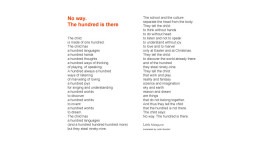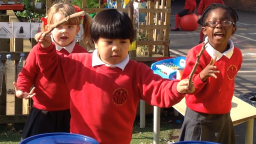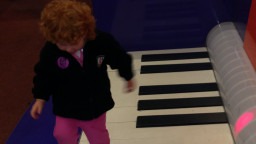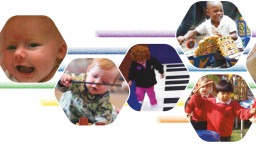Exploring and Playing
Music or noise?
Go into any early years setting and it is likely that you will hear an abundance of sound – children talking, laughing, singing and generally making sounds with instruments and any resources they can get their hands on. Rightly so.
What does children’s music sound like? When we think of children’s paintings and drawings I imagine that most of us have an idea of what a young child’s picture may look like but when we try to imagine what a child’s piece of music sounds like, it is maybe much more difficult. This is perhaps because we don’t always hear children’s creative music and it is not well documented. Ask yourself – would you ever draw over a child’s drawing or paint over a child’s painting? Children’s creative music making is often not heard, spoken over and is not recognised as music. Have a listen to this piece of music:
This piece of music was created by a 3-year-old in a children’s centre. I am sure that you can hear the very distinctive pattern in this music. This piece of music is far from random but could quite easily go unheard or could be disregarded as noise.
Music is trickier as an art form to document compared to visual art as it is live and once it has been created in that moment it disappears - unless we capture it. There are a range of recording devices which are easily available today such as Dictaphones, Easi-Speak microphones and iPads, as well as cameras and video cameras to capture the accompanying visual image. Playing children’s music back to children and sharing it with parents can be a highly valuable experience; it shows children that we are listening, we can hear them and we value their music. Next time you have the opportunity to observe children making music, try to take time out to really listen carefully to the music that is created and where possible record it.
Enabling Musical Environments
Compare your visual art provision to your music provision – how does it compare? Are there more opportunities for children to engage in visual art experiences? Also compare the range of resources you have in your visual art provision compared to your music provision, carry out an audit of your musical resources. Throw away any broken instruments or invest in some time to repair them. Ensure that your triangles have the string attached and beater in place, untangle the ropes of the Indian bells so that children can actually play them.
Children will be creative with monochrome pencil crayons but perhaps they are able to be more expressive when they are offered a range of colours, the same can be said of music. Children will be creative with the percussive instruments that tend to be offered, but children may be enabled to be more musically expressive and creative if offered a range of colourful sounds to play with. This does not mean the colour of the instrument itself, this is referring to the sound quality of the instrument. The instruments that are usually offered in early childhood settings are percussion instruments and the provision doesn’t often include tuned instruments. Tuned instruments are instruments that produce different pitches (high and low sounds) e.g. a xylophone. If budget for musical resources is challenging, then keep in mind the phrase ‘less is more’. Invest in 1 quality instrument rather than multiple hand-held plastic instruments that are likely to need replacing.
You can encourage children to make music by setting out music areas which are inviting for children to create music. Keeping instruments in baskets, drawers or on trolleys can be a very practical storage solution but children may not always remember that they are there and may not access them. If instruments are set out to invite children to play you may see that children make music more readily. Try setting out instruments inside and outside and explore the use of levels, e.g. instruments on tables, on the floor. Show children that you value their music by actively listening to it and perhaps inviting them to share their music with others. Some children may love the opportunity to perform to others and this can be included within group activities. Invite children to create pieces of music 1 by 1 within group activities and encourage other children to listen and then talk about it together.
You can download a report regarding ‘Enabling Musical Environments’ here.
Within the Enabling Environments theme of Musical Development Matters, you will see statements such as:
- Experiment with the use of levels eg instruments on tables, on the floor, instruments indoors and outdoors, group instruments together eg place instruments together in a basket that can be shaken, tapped, scraped.
- Create environments that invite children to make music together, eg a music table against a wall does not promote interactive and social music making, a music table with space around enables children to communicate musically and make music together more easily. Playing with a partner may impact how children make music.
Children’s music can quite easily be disregarded as noise. Next time you hear a child banging a drum, tapping blocks together or playing a set of chime bars, listen carefully to the music they are creating, you may hear patterns, structure and elements of music that may have gone unheard before.
Listen to this piece of music:
This piece was created by a 3-year-old child. The music involves 2 instruments that the child selected and laid out to play.
What can we hear?
Here are some suggestions:
- Structure – alternating between one instrument and the next
- Consistent tempo (speed)
- Music full of energy
This piece was captured on a Dictaphone and shared with the child’s parents.
Young (2003) investigated the spontaneous instrumental music-making of three- and four-year-olds in early years settings in London. Young argues that many prior studies of children’s music-making have analysed and evaluated such activity against models drawn from the practices of western art music and its conventions of analytical theory and suggests that this approach has certain drawbacks.
As stated in Musical Development Matters:
Music should not be quantified by performer-listener and should not only be judged by how music is perceived in western culture.
Children’s instrumental music play isn’t typically observed with types of play in mind; it is often observed from an adult musical perspective, what is understood to be ‘music’ and what skills are required to be a ‘musician’. Observing children’s musical play in this way, can diminish and devalue children’s music making and often results in children’s music making being described as noise.
Stewart (2011, p.23) discusses types of play and draws upon the five types of play that has been categorised by play researchers:
- Physical play
- Play with objects
- Symbolic play
- Pretend and socio-dramatic play
- Games with rules
Observing children’s musical play and carefully considering the ‘type’ of play may enable us to understand children’ s music making in more depth.
Young (2003), offers a review of prior studies investigating young children’s music making with instruments and also discusses families of different kinds of musical activity. Young also points out that ‘adult priorities rarely coincide with children’s and that a xylophone primed for educational purposes to promote musical activity will be appropriated by the child for diverse play’. (p.51).
In Music 3-5 (Young, 2009, p.97-101), different types of playing with instruments are suggested:
- Body movements
- Exploring the instrument
- Combining instruments
- Playing a song
- Making up a role play
- Playing with someone else
- Mixing ideas
- Chaining and linking ideas
- Group work with instruments
The types of play listed above by Stewart (2011) and Young (2009) can offer a template for observing and understanding children’s instrumental musical play.
Observe the children in the following clip:
What can we see and hear happening in this clip?
Here are some suggestions:
- Play with objects (instruments)
- Games with rules (intermittently)
- Combining instruments
- Playing with someone else
- Vocalising whilst playing
Observe the child in the following clip:
What can we see and hear happening in this clip?
Here are some suggestions:
- Exploring the instrument
- Singing whilst playing
- At times keep a steady beat whilst singing
- Clear ending and a sense of performance
Observe the children and adults in the following 2 clips:
Huge thanks to Take Art, Soundwaves for sharing these film clips. https://takeart.org/soundwaves-extra
What can we see and hear happening in these clips?
Here are some suggestions:
- Interactive musical play
- Non-verbal communication
- Sensitive, responsive adults
- Exploring ‘games with rules.’
- Combining Instruments
Points to consider
There are currently many initiatives to support children with their speech and language development. There is however, currently such a focus on phonics, phonological awareness and ‘speech’ that there is a danger in losing sight of the many languages that children communicate through; one of these many forms being music.
Loris Malaguzzi from Reggio Emilia so eloquently wrote the poem, The Hundred Languages of Children:

A recent music, speech and language project, SALTmusic, took place in Great Yarmouth. The artists and speech and language therapists involved adopted a ‘talk-poor, sound-rich approach’ This had incredibly positive outcomes for children and families. As well as sound play there was an effective use of silence. The silence gave space for children’s communicative expressions to be heard and valued. This enabled children to interact and this was not focused on ‘speech’ as perhaps other speech and music language projects are.
You can read about the project here: https://network.youthmusic.org.uk/saltmusic-research-report
You can download the full SaltMusic project report here.
Observe the following clip:
Huge thanks to Take Art and the Inspire-music project for this clip.
http://www.inspire-music.org/case-studies/65-jane-parker-soundwaves-extra
What can we see and hear happening in these clips?
There are many suggestions offered throughout the clip. Similarly to the 2 clips above, the communication is non-verbal, powerful and meaningful.
Observe the following clip:
What can we see and hear happening in this clip?
Here are some suggestions:
- Playing a drum sophisticatedly
- Playing the pulse of the music
- Playing along with the rhythm in the music
This clip is from Tune into Listening, a free online resource regarding the effective use of recorded music in early years settings: https://macbirmingham.co.uk/project/tune-into-listening-project
You can access the other 3 aspects of Musical Development Matters by clicking below:
References
Stewart, N., 2011. How children learn. The Characteristics of effective learning. London: Early Education
Young, S., 2009. Music 3-5 (The Nursery World / Routledge Essential Guides for Early Years Practitioners). Abingdon: Routledge.
Young, S., 2003. Time–space structuring in spontaneous play on educational percussion instruments among three- and four-year-olds. British Journal of Music Education, 20 (1), pp. 45-59.



